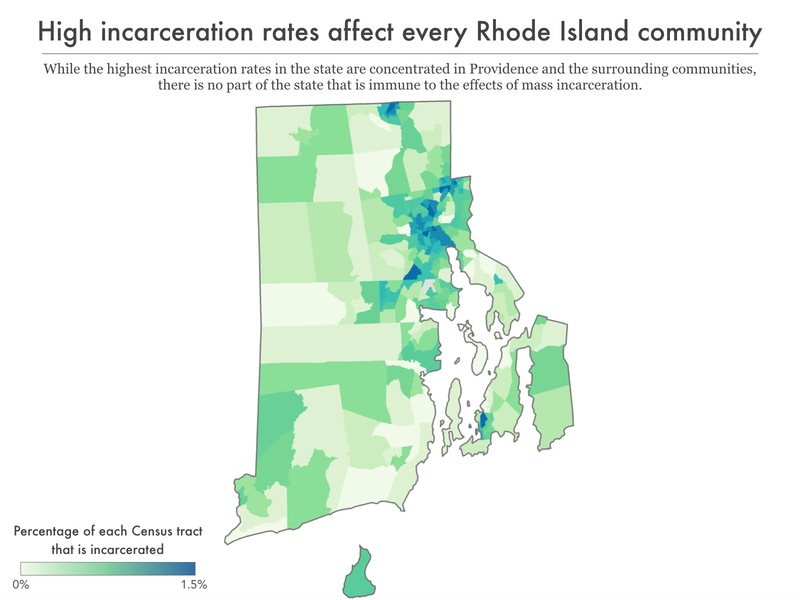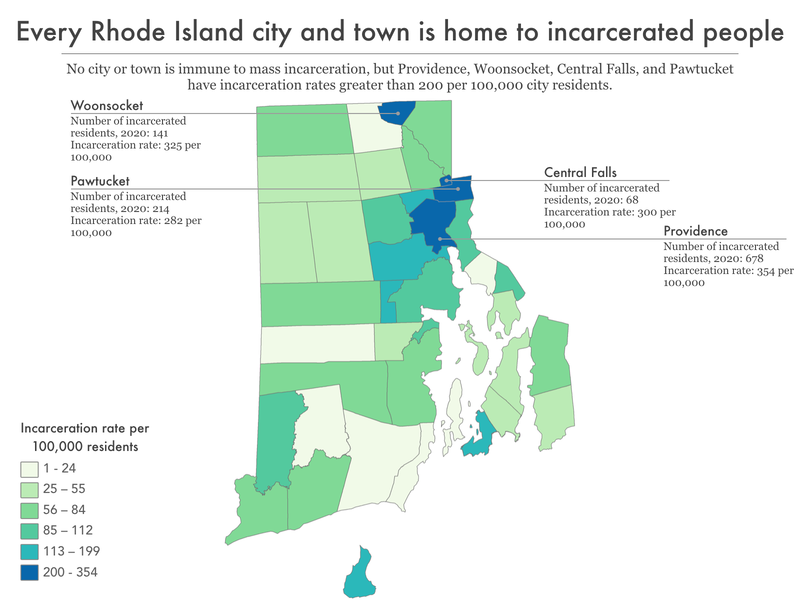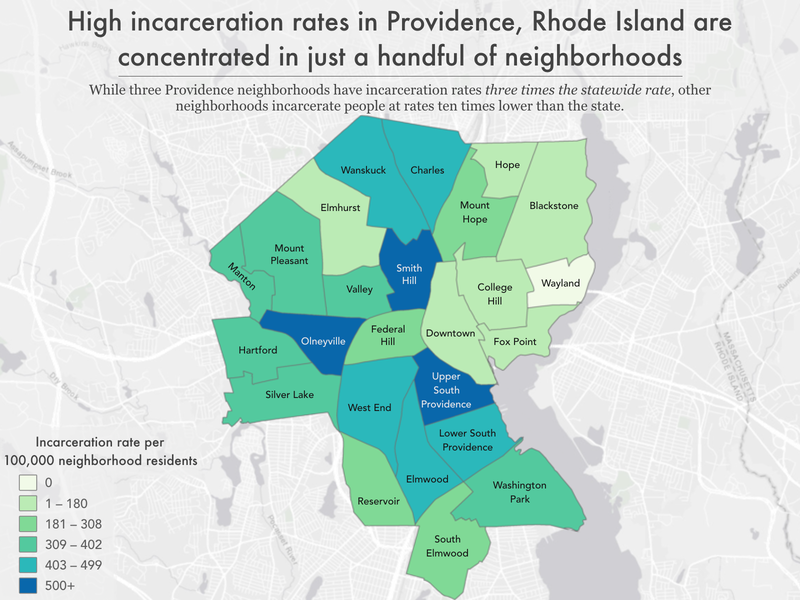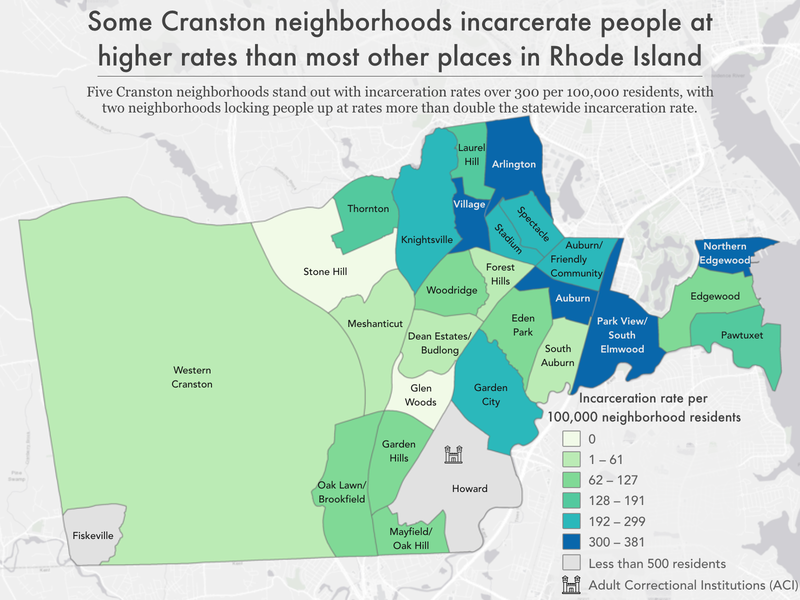Where people in prison come from:
The geography of mass incarceration in Rhode Island
by the Prison Policy Initiative, the Redistricting Data Hub (Peter Horton and Spencer Nelson), Common Cause Rhode Island, and the American Civil Liberties Union of Rhode Island
October 2023
Press release
One of the most important criminal legal system disparities in Rhode Island has long been difficult to decipher: Which communities throughout the state do incarcerated people come from? Anyone who lives in or works within heavily policed and incarcerated communities intuitively knows that certain neighborhoods disproportionately experience incarceration. But data have never been available to quantify how many people from each community are incarcerated with any real precision.1
But now, a unique dataset from the Department of Corrections offers a chance to better understand the geography of incarceration in Rhode Island.2 Using this dataset, we found that in Rhode Island, the state’s largest city — Providence — is incarcerating the most people, but other smaller cities — like Woonsocket and Central Falls — and less populous counties — including Kent and Newport counties — are also missing a significant share of their population to incarceration.3 And a deeper dive into the data shows that even within cities there are dramatic differences in rates of incarceration between neighborhoods, often along racial and socioeconomic lines. These data show that — big or small — every community in Rhode Island is harmed by mass incarceration.
In addition to helping policymakers and advocates effectively bring reentry and diversion resources to these communities, this data has far-reaching implications. Around the country, high incarceration rates are correlated with other community problems related to poverty, employment, education, and health. Researchers, scholars, advocates, and politicians can use the data in this report to advocate for bringing more resources to their communities.
Incarcerated people come from everywhere, although disproportionately from some places more than others
Our analysis of the Rhode Island Department of Corrections' data shows that incarcerated people come from every single Rhode Island city and town, and that a handful of communities bear the heaviest burden from mass incarceration.5 This report’s analysis of the distribution of pre-incarceration homes is based on our reallocation of more than three-quarters of the in-custody population to addresses outside of correctional facilities.6
In order to make apples-to-apples comparisons of the prevalence of incarceration between counties, cities, and other communities of different sizes, this report uses incarceration rates expressed as the number of people incarcerated per 100,000 residents. For the purposes of this analysis — looking only at the numbers of people who were successfully reallocated to specific non-prison addresses in the state — Rhode Island has an incarceration rate of 162 per 100,000 residents.7
City and town trends
While every Rhode Island city and town is home to an incarcerated person, some of Rhode Island’s 39 cities and towns have far more residents incarcerated than others. With an incarceration rate of 354 people incarcerated per 100,000 city residents, Providence has the highest incarceration rate in the state. Providence is home to 17% of the state’s population, but 38% of the state’s incarcerated population. Given that the criminal legal system unfairly targets communities of color — particularly Black and Latino communities — Providence’s high incarceration rate may be of no surprise, as the city’s population is 16% Black and 43% Hispanic or Latino, while the statewide population is only 9% Black and 18% Hispanic or Latino. People in the custody of the Rhode Island Department of Corrections are disproportionately Black and Hispanic or Latino as well: in June 2019, 29% of the sentenced population was Black and 24% of the sentenced population was Hispanic or Latino.
A handful of less populous cities and towns appear to be incarcerating large portions of their populations, as well, despite smaller overall populations. The city of Woonsocket — along the northern border of the state — has the second highest citywide incarceration rate in the state: 325 per 100,000 city residents, with 141 of its 43,000 residents incarcerated. Other cities with high incarceration rates include Central Falls (300 per 100,000), Pawtucket (284 per 100,000), and Newport (198 per 100,000). One thing these five high-incarceration cities have in common is an elevated poverty rate. For example, Central Falls, with a poverty rate of 25%, and Providence, with a rate of 22%, are more than twice the statewide poverty rate of 11%. The high rates of incarceration in these cities with particularly high poverty rates may not be surprising, given that poor people and their families and communities are disproportionately impacted by the criminal legal system.
In contrast, Rhode Island cities and towns with the lowest incarceration rates tend to be predominantly white and have poverty rates far below the state average. For example, the town of Barrington has an incarceration rate of 12 per 100,000 with a population that is 91% white and a poverty rate of 5%. Despite the much lower overall incarceration rate in a town like Barrington, we still see the effect of over-policing communities of color: while Black people are less than 1% of the town’s population, they make up 7% of arrests made by the Barrington Police Department.
Neighborhood trends
Within Rhode Island cities, incarceration tends to be concentrated in a relatively small number of geographic areas and neighborhoods.
Providence
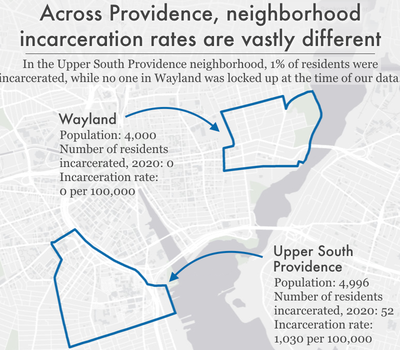
Given what we know about how policing targets low-income communities and communities of color, it is not surprising that Providence - with a population that is 16% Black, 43% Hispanic or Latino, and 22% living in poverty - has the highest citywide incarceration rate. But the residence data available in this report allows us to look at a more granular level: neighborhood incarceration rates.
Nine of the 25 Providence neighborhoods8 have incarceration rates greater than 400 people incarcerated per 100,000 residents, suggesting that some neighborhoods are particularly vulnerable to the criminal legal system.
Historically, Providence is one of the starkest examples of redlining in the country. In the 1930s, the federal government rated the “riskiness” of real estate investment in different neighborhoods, resulting in rating non-white neighborhoods as “hazardous” and beginning a cycle of disinvestment in these predominantly Black and immigrant neighborhoods. A 2019 study of formerly redlined neighborhoods in over 100 cities found that these neighborhoods are lower-income and are more likely to be home to Black and Hispanic or Latino residents. In Providence, the neighborhoods with the highest incarceration rates in 2020 are also the neighborhoods that were “redlined” in the mid-20th century. For example, the neighborhood of Upper South Providence was considered “definitely declining” during redlining, resulting in the community becoming home to predominantly non-white residents. In 2019, Upper South Providence was 34% Black, while the city of Providence itself is only 16% Black. And compared to the Blackstone, Wayland, and College Hill neighborhoods to the northeast - parts of which were considered the “best” and “still desirable” for real estate investment during redlining - Upper South Providence’s incarceration rate in 2020 was more than twenty times higher than the rates in these predominantly white neighborhoods, suggesting that the long-lasting consequences of the racist redlining practices of the 20th century persevere in modern day policing and incarceration trends.
Cranston
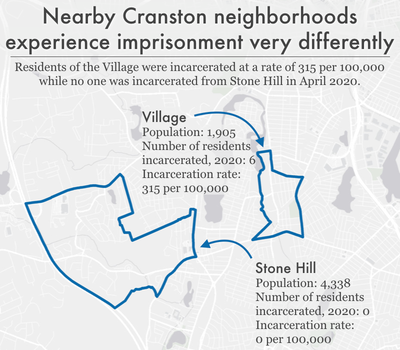
Compared to Providence, Cranston has a much lower incarceration rate: 156 per 100,000 residents. In fact, Providence city residents are twice as likely to be incarcerated than residents of Cranston.
Cranston has a relatively lower percentage of Black residents - only 6% of Cranston residents are Black, compared to 16% of Providence residents - and Cranston also has a poverty rate of 8%, much below most other Rhode Island cities. But the same trends persist in Cranston as in the other cities across the country: Black people are over four times more likely to be arrested for low level, non-violent offenses than a white person in Cranston 9 Both Black and Hispanic or Latino residents are disproportionately policed by the Cranston Police Department: 18% of arrests are of Black people and 25% of arrests are of Hispanic or Latino people, while only 6% of the city residents are Black and 16% are Hispanic or Latino.
Looking more closely, it becomes clear that certain communities and neighborhoods within the same city are disproportionately affected by the criminal legal system.10 For example, the Village neighborhood had one of the highest incarceration rates in the city at 315 per 100,000 residents. But just a few miles west, the incarceration rate in the neighborhood of Stone Hill was 0 per 100,000 in April 2020, with no residents incarcerated at the time of our data. In a city that disproportionately polices Black and Hispanic or Latino residents, it is not surprising to note that residents of the Village neighborhood are 11% Black and 35% Hispanic or Latino, while Stone Hill residents are only 5% Black and 10% Hispanic or Latino. According to the same Census data, other low-incarceration Cranston communities like Western Cranston, South Auburn, and Eden Park are also predominantly white.11 The comparison between these areas highlights the stark differences in neighborhood-level incarceration trends, despite the relatively low citywide incarceration rate. As we know, poorer communities of color across the country have experienced decades of systematic oppression and divestment by the public and private sectors, as well as a history of over policing— leaving them particularly vulnerable to a modern-day reliance on mass incarceration.
What are the differences between high- and low-incarceration communities?
Across the country, researchers have connected high local incarceration rates with a host of negative outcomes for the people who live there. In the Prison Policy Initiative’s analysis of where incarcerated people in Maryland are from in 2010, we found that Baltimore communities with high rates of incarceration were more likely to have high unemployment rates, long average commute times, low household income, a high percentage of residents with less than a high school diploma or GED, decreased life expectancy, high rates of vacant or abandoned properties, and higher rates of children with elevated blood-lead levels, compared to neighborhoods less impacted by incarceration.
Research has revealed similar correlations12 in communities around the country:
- Life expectancy: A 2021 analysis of New York State census tracts found that tracts with the highest incarceration rates had an average life expectancy more than two years shorter than tracts with the lowest incarceration rates, even when controlling for other population differences.13 And a 2019 analysis of counties across the country revealed that higher levels of incarceration are associated with both higher morbidity (poor or fair health) and mortality (shortened life expectancy).
- Community health: A nationwide study, published in 2019, found that rates of incarceration were associated with a more than 50% increase in drug-related deaths from county to county. And a 2018 study found that Black people living in Atlanta neighborhoods with high incarceration rates are more likely to have poor cardiometabolic health profiles.
An analysis of North Carolina data from 1995 to 2002 revealed that counties with increased incarceration rates had higher rates of both teenage pregnancy and sexually transmitted infections (STIs). A 2015 study of Atlanta also found that census tracts with higher rates of incarceration had higher rates of newly diagnosed STIs.14 - Mental health: A 2015 study found that people living in Detroit neighborhoods with high prison admission rates were more likely to be screened as having a current or lifetime major depressive disorder and generalized anxiety disorder.
- Exposure to environmental dangers: A 2021 study found that people who grew up in U.S. census tracts with higher levels of traffic-related air pollution and housing-derived lead risk were more likely to be incarcerated as adults, even when controlling for other factors.
In New York City, neighborhood incarceration rate is associated with asthma prevalence among adults. Similarly, in our 2020 analysis of New York City neighborhoods, we found higher rates of asthma among children in communities with high incarceration rates.15 - Education: In a 2020 analysis of incarcerated New Yorkers’ neighborhoods of origin from the Prison Policy Initiative, we found a strong correlation between neighborhood imprisonment rates and standardized test scores.16 And a 2017 report on incarceration in Worcester, Mass., found that schools in the city’s high-incarceration neighborhoods tended to be lower-performing. What’s more, students in those neighborhoods faced more disciplinary infractions. In 2017, the ACLU of Washington found that some Washington school districts are more likely to assign police to schools with higher than average populations of students of color and low-income students.
- Community resources and engagement: A 2018 study found that throughout the country, formerly incarcerated people (as well as all people who have been arrested or convicted of a crime) are more likely than their non-justice-involved counterparts to live in a census tract with low access to healthy food retailers. And the 2017 report on Worcester, Mass., revealed that high-incarceration neighborhoods had lower voter turnout in municipal elections.
We already have this wealth of data showing that incarceration rates correlate with a variety of barriers and negative outcomes. The data in this report build on this work by helping identify which specific neighborhoods throughout Rhode Island are systematically disadvantaged and left behind. Rhode Island residents can use the data in this report to examine granular local-level and state-wide correlations and choose to allocate needed resources to places hardest hit by incarceration.
Implications & uses of this data
These eleven data tables provided here have great potential for community advocacy and future research.
First and most obviously, these data can be used to determine where the need is greatest for community-based programs that help prevent involvement with the criminal legal system, such as offices of neighborhood safety and mental health response teams that work independently from police departments. The data can also help guide reentry services (which are typically provided by nonprofit community organizations) to areas of Rhode Island that need them most.
But even beyond the obvious need for reentry services and other programs to prevent criminal legal system involvement, our findings also point to geographic areas that deserve greater investment in programs and services that indirectly prevent criminal legal involvement or mitigate the harm of incarceration. After all, decades of research show that incarceration leads to cascading collateral consequences, both for individuals and their loved ones. When large numbers of people disappear from a community, their absences are felt in countless ways. They leave behind loved ones, including children, who experience trauma, emotional distress, and financial strain. Simultaneously, the large numbers of people returning to these communities (since the vast majority of incarcerated people do return home) face a host of reentry challenges and collateral consequences of incarceration, including difficulty finding employment and a lack of housing. People impacted by the criminal legal system tend to have extremely diminished wealth accumulation. And those returning from prison and jail may carry back to their communities PTSD and other mental health issues from the trauma they’ve experienced and witnessed behind bars. Lastly, investing in core community resources to mitigate structural issues like poverty, such as housing and healthcare, will reduce vulnerabilities for criminal legal system contact.
And since we know place of origin correlates with so many other metrics of wellbeing, we can and should target these communities for support and resources beyond what we typically think of as interventions to prevent criminal legal system contact. In communities where the state or city has heavily invested in policing and incarceration (i.e. the high-incarceration neighborhoods we find in our analysis), our findings suggest that those resources would be better put toward reducing poverty and improving local health, education, and employment opportunities.
For example, we know that large numbers of children in high incarceration areas may be growing up with the trauma and lost resources that come along with having an incarcerated parent, and that these children are also more likely to experience incarceration. The information in this report can help with planning and targeting supports, resources, and programming designed to not only respond to the harms caused by incarceration, but disrupt the cycle of familial incarceration.
We invite community leaders, service providers, policymakers, and researchers to use this data to make further connections between mass incarceration and various outcomes, to better understand the impact of incarceration on their communities.
Methodology & data
The Rhode Island Department of Corrections provided the underlying data for this project pursuant to a data-sharing agreement with the Prison Policy Initiative and Redistricting Data Hub in May 2023. This report and its state-wide analysis of where incarcerated people in Rhode Island call home builds upon an analysis of 1,780 home addresses of people in the custody of the Rhode Island Department of Corrections as of April 2020. These 1,780 addresses represent a sample of approximately 78% of the total incarcerated population, and we discuss the origins and significance of this sample below.
This section of the report discusses how we processed the data, some important context and limitations on that data, and some additional context about the geographies we chose to include in this report and its appendices. The goal of this report is not to have the final word on the geographic concentration of incarceration, but to empower researchers and advocates — both inside and outside of the field of criminal justice research — to use our dataset for their own purposes. For example, if you are an expert on a particular kind of social disadvantage and have some data organized by county, zip code, school district, or other breakdown and want to add incarceration data to your dataset, we probably have exactly what you need in a prepared appendix described below.
This report can also be seen as a template for other states because most state departments of corrections already have near-complete home residence records in an electronic format. States - including Rhode Island - should be encouraged to continue improving their data collection, and to share the data (under appropriate privacy protections) so that similar analyses could be performed.
How we processed the data
The Rhode Island Department of Corrections provided a dataset of the addresses for the 2,422 people in the custody of the department in 2020.18 The Redistricting Data Hub then determined which census block each address provided was in, and then aggregated these counts up to the census tracts, neighborhoods and a number of useful state-wide geographies such as counties, state legislative districts, congressional districts, and even some city-wide geographies such as neighborhoods in Providence and Cranston.
Of the original 2,422 records, Redistricting Data Hub removed 544 records prior to using the Google geocoding API. Some records were removed because they contained addresses that were from out of state, incomplete, or obviously not a home address.19 Of the 1,878 of remaining records a latitude, longitude coordinate was retrieved for 1,877. The Redistricting Data Hub queried down the latitude and longitude results to just those of range interpolation or rooftop methods resulting in 1,802 geocoded records. After spatially joining the results to census blocks in Rhode Island, 1,799 records were successfully assigned to appropriate Rhode Island census blocks. As a last step, 19 records were removed because they were geocoded back to a Census block with a correctional facility and their last known addresses matched a facility address. Therefore, the Redistricting Data Hub was able to successfully assign 1,780 incarcerated people back to a valid last known address.
Finally, the Redistricting Data Hub calculated incarceration rates for each geography, by first calculating a corrected population that shows the non-incarcerated population plus the net change in the number of incarcerated people from that geography; and then dividing the number of incarcerated people by that corrected population, and then multiplying it by 100,000 to get an incarceration rate per 100,000.
Important context and limitations on this data
Our analysis in this report documents the home addresses of 1,780 people in the custody of the Rhode Island Department of Corrections in April 2020. Not included in this analysis are several other groups of Rhode Island residents who are incarcerated in other types of facilities:
- Incarcerated in a federal prison; because states do not have the power to require home address data from federal agencies.
- Incarcerated in another state’s prison system; because states cannot require other states to share this information.
About the geographies
We’ve organized the data in this report around several popular geographies, as defined by the federal government, by the state, or by individual cities, with the idea that the reader can link our data to the wealth of existing social indicator data already available from other sources.
Unfortunately, the reader may desire data for a specific geography that we have not made available — for example, their own neighborhood, as they conceive of its boundaries. Often, there was not a readily accessible and official map that we could use that defined that boundary; so where the reader has this need, we urge the reader to look for other geographies in our datasets that can be easily adapted to their needs, either one that is similar enough to their preferred geography or by aggregating several smaller geographies together to match your preferred geography.
We also want to caution subsequent users of this data that some geographies change frequently and others rarely change, so they should note the vintage of the maps we used to produce each table. For example, county boundaries change very rarely, and when they do, it is often in extremely small ways. On the other hand, state legislative districts in some areas may change significantly, so depending on your goals some specific tables may be more or less applicable for your future use.
Finally, readers should note that occasionally the incarcerated numbers in our tables for some geographies will not sum precisely to the total 1,780 home addresses used in this report. That discrepancy arises because of how census blocks - the basic building block of legislative districts - nest or fail to nest within geographies drawn by agencies other than the Census Bureau.
Footnotes
The Prison Policy Initiative recently published twelve similar state reports available at /origin/ using those states’ redistricting data or, in the case of Louisiana and this Rhode Island report, data from the state prison system to fill this need. ↩
This is not the first report of its kind in Rhode Island. A 2004 report from the Rhode Island Family Life Center, Political punishment: The consequences of felon disenfranchisement for Rhode Island communities, Marshall Clement and Nina Keough expertly authored a detailed, community-level analysis of the impact of Rhode Island’s felony disenfranchisement law on the state’s eligible voting population. This 2004 report similarly used data provided by the state Department of Corrections to identify the home communities of people in Rhode Island Department of Corrections’ custody. ↩
Incarceration rates per 100,000 are a useful tool for comparison between different geographic regions with varying population sizes. For example, using a rate per 100,000 allows us to compare the frequency of incarceration between the most populous Rhode Island city with over 191,000 residents - Providence - with much less populous cities like Central Falls, with just over 22,000 residents, or Cranston, with almost 83,000 residents. ↩
While we were not able to identify official neighborhood boundaries for all cities and communities in Rhode Island, a local-level analysis of community incarceration trends could be conducted using the incarceration rates by census tracts, published in the appendix. ↩
Rhode Island is one of six states with integrated jail and prison systems. People who have been sentenced and those held pretrial are under the authority of the Department of Corrections. The Department of Corrections traditionally differentiates population data by “sentenced” or “unsentenced” but for the purposes of this report, we are referring to the total combined Department of Corrections population in Rhode Island. ↩
As we discuss in the methodology, not everyone in Rhode Island Department of Corrections’ custody could be reallocated to a home address — for example people incarcerated in Rhode Island who are residents of other states — and there were also addresses on file that were not, for a variety of reasons, able to be reallocated back to specific places in Rhode Island. ↩
As explained in the methodology, this report’s incarceration rate is based on the 78% of people in the custody of the Rhode Island Department of Corrections that we were able to successfully reallocate to their home addresses. This number is necessary for making apples-to-apples comparisons of incarceration between specific Rhode Island communities and the state as a whole. For the purposes of comparing incarceration in Rhode Island with that of other states, other more common metrics would be more useful. For these other uses, we would recommend using other numbers for the statewide incarceration rate, likely either the 131 per 100,000 published by the Bureau of Justice Statistics in Prisoners in 2021 for the number of people in state prison per 100,000 residents, or the more holistic number of 289 per 100,000 residents used in States of Incarceration: The Global Context 2021 that includes people in state prisons, federal prisons, local jails, youth confinement, and all other forms of incarceration. ↩
For this analysis, we looked at neighborhoods as defined by the City of Providence. ↩
In this analysis from the Police Scorecard Project, “low-level” offenses are typically classified as misdemeanors and include the following types of offenses: drug offenses, public drunkenness and other alcohol-related offenses; vagrancy, loitering, gambling, disorderly conduct, prostitution, vandalism, and “other minor non-violent offenses.” ↩
For this analysis, we looked at neighborhoods as defined by the City of Cranston’s Canvassing Authority. ↩
The Village neighborhood contains most of Providence County Census tract 147. The Stone Hill neighborhood contains most of Providence County Census tract 148 and a small part of Providence County Census tract 145.02. For the demographic data presented here on the Village and Stone Hill neighborhoods, we utilized tract-level data for Census tract 147 and Census tract 148 available from the U.S. Census Bureau's 2021 ACS 5-Year Estimates Detailed Tables, Table B03002. ↩
These various correlative findings are once again in line with previous research on health disparities across communities, which have been linked to neighborhood factors such as income inequality, exposure to violence, and environmental hazards that disproportionately affect communities of color. Public health experts consider community-level factors such as these — including incarceration — “social determinants of health.” To counteract these problems, they suggest taking a broad approach, addressing the “upstream” economic and social disparities through policy reforms, as well as by increasing access to services and supports, such as improving access to clinical health care. ↩
We also know that people who have been incarcerated have a shorter life expectancy than people who have not. ↩
There are many additional studies linking incarceration rates and high community rates of STIs, including gonorrhea and chlamydia in North Carolina. ↩
Asthma prevalence has been used as a tool to measure population health in both sociological and public health research because it is easily correlated with environmental factors, like air quality and triggers (i.e. second hand smoke, mold, dust, cockroaches, dust mites), access to appropriate healthcare, and healthcare literacy. See the American Lung Association’s Public Policy Position for a literature review of the relevant public health research. ↩
This finding is consistent with previous research on the relationship between education and incarceration rates. The Prison Policy Initiative previously reported that the high school educations of over half of all formerly incarcerated people were cut short. This is in line with earlier studies showing that people in prison have markedly lower educational attainment, literacy, and numeracy than the general public, and are more likely to have learning disabilities. We also know there are relationships between parental incarceration and educational performance. ↩
The Rhode Island Department of Corrections started with a relatively good data system, and these systems continue to improve. For example, the state recently passed legislation requiring the Department of Corrections to collect certain information about all the people entering their custody, although that legislation did not explicitly require the Department of Corrections to improve its collection of accurate and complete addresses. We encourage the General Assembly to amend the law to include this requirement and, in the meantime, we call on the Department of Corrections to consistently collect that information as part of its intake process. ↩
Of note, this dataset includes all people in the custody of the Rhode Island Department of Corrections on a single date in April 2020 and does not include any people in federal Bureau of Prisons custody. In April 2020, the average total population was 2,295 people, with 1,770 who had been sentenced and the remaining 525 people awaiting trial (see “Average Total Population by Month Calendar Year 2020” and “Average Monthly Sentenced Population Calendar Year 2020” in the CY20 Population Update from the Rhode Island Department of Corrections). ↩
This level of detail is irrelevant to the findings of this report about the spatial concentrations of incarceration in Rhode Island, but may be useful to the state redistricting officials or the Census Bureau who are considering various reforms to end the problem of prison gerrymandering because these officials often desire additional detail about the current “quality” of the home address data held by the various prison system. Of course, “quality” is not an absolute measure and instead depends on the goals of the project. For example, there were records that lacked a last known address and therefore could not be mapped, but with enough future notice the prison system could collect better data from those individuals if it wished to. And the 147 records that contained out-of-state addresses would be irrelevant to this project seeking to determine where in Rhode Island people in Department of Corrections custody come from, but would be relevant and useful to the Census Bureau should that agency want to count incarcerated people as residents of their home addresses nationwide.
The criteria Redistricting Data Hub used to filter out records, the order in which they applied those filters, and the number of records that were filtered at that stage of the work is as follows:
- Out of state addresses (147)
- No permanent address or listed address as “homeless” (83)
- Address did not contain a street number (310)
- Address did not contain a street name (1)
- Address did not contain a city (3)
Of the 83 records without a permanent address or listed address as “homeless,” 18 records included a specific city or town. We chose - in order to allow comparisons between different geographies - to not include these people in the city or town totals. The breakdown of these 18 records by city or town was: 11 from Providence, 2 from Newport, and 1 each from Coventry, Cranston, East Providence, Johnston, and Warwick.
Of the 310 records without a street number, 122 records included a specific city or town. We chose - in order to allow comparisons between different geographies - to not include these people in the city or town totals. The breakdown of these 122 records by city or town was: 63 from Providence, 11 from Pawtucket, 10 from Woonsocket, 5 from Cranston, 4 from Wawrick, 4 from Central Falls, 4 from Newport, 2 from Warren, 2 from Westerly, 2 from Narragansett, 2 from West Warwick, and 1 each from Charlestown, Cumberland, East Providence, Hopkinton, Johnston, Lincoln, Middletown, New Shoreham, North Providence, Portsmouth, Scituate, Smithfield, and Tiverton. ↩
Acknowledgments
The authors thank their funders and the Rhode Island Department of Corrections for providing the necessary data for this report.
About the organizations
The non-profit, non-partisan Prison Policy Initiative produces cutting edge research to expose the broader harm of mass criminalization, and then sparks advocacy campaigns to create a more just society. In 2002, the organization launched the national movement against prison gerrymandering with the publication of Importing Constituents: Prisoners and Political Clout in New York addressing how using Census Bureau counts of incarcerated people as residents of the prison location diluted the votes of state residents who did not live next to prisons in violation of the state constitutional definition of residence. Since then, New York — and more than a dozen other states — have used the Prison Policy Initiative’s research to pass laws ending prison gerrymandering.
The non-partisan Redistricting Data Hub provides individuals, civic organizations, and good government groups the data, resources, and knowledge to participate effectively in redistricting processes by learning how to define their communities, provide meaningful public input, recognize gerrymandering, and advocate for fair and legal maps. In service of this mission, it hosts over 15,000 datasets across all 50 states, from the census block to the district level, and continues to add new data that is useful for map drawing and analysis. This data is free to the public, and accompanied by technical support and nonpartisan analysis on request.
The American Civil Liberties Union of Rhode Island is a non-profit, non-partisan organization that works to defend and advance civil liberties and civil rights in Rhode Island via an integrated advocacy model that uses public engagement, public policy, and strategic litigation to seek justice. The ACLU of Rhode Island has campaigned for ending Rhode Island’s practice of prison gerrymandering for over a decade using all of these mechanisms in order to ensure that the votes of incarcerated individuals count.
Common Cause Rhode Island is a nonpartisan organization that promotes representative democracy by ensuring open, ethical, accountable, effective government processes at local, state, and national levels by educating and mobilizing the citizens of Rhode Island. Common Cause Rhode Island has campaigned to end Rhode Island’s practice of prison gerrymandering since 2009.
